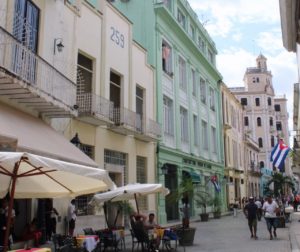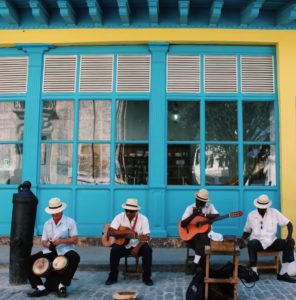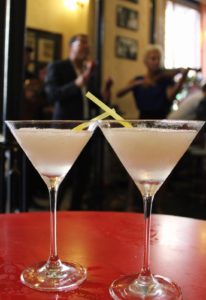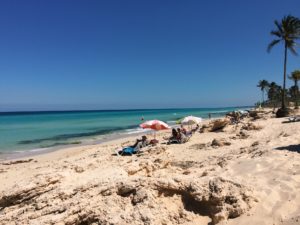No, Dorothy, we are definitely not in Kansas anymore.
Havana is a vibrant city that seems to be perpetually caught between its revolutionary past and its seemingly uncharted future. It is a city of contrasts, which can be found in nearly every interaction or experience, making Havana all the more enchanting, unique, and bewildering.
En route to the city from José Martí International Airport, this contrast can be seen no matter which seat in the car you choose. Tourists wearing straw hats and designer sunglasses are eager to snap a picture as they zip past a 20-foot tall “Socialismo o Muerte” mural, hung proudly on a building that is visible out the driver’s side of an old fashioned car. On the passenger’s side, a string of goats, cows, and chickens wander alongside the road, making their way towards a group of Cubans waiting for the bus to arrive at a bus stop they’ve organized themselves. Colorful homes and businesses frame Havana’s bustling streets, each one more unique than the last, yet nearly all contain the same portrait of a young Che Guevara, the revolutionary. In Old Havana, a young Cuban girl dances traditional salsa with a boy in a bar to a live rendition of “Guajira Guantanamera,” while tourists hurry to record them on their iPhones for their social media followers back home before their last hour of Wi-Fi runs out. These contrasts shape Havana, a place where the past and the present exist not as a dichotomy, but instead as a reciprocal duo engaged in a harmonious salsa dance.
American onlookers can now observe this Cuban contrast in a city where the live music is constant, the energy is contagious, and the coffee, rum, and cigars make their American counterparts moot. It’s no wonder that with the U.S. travel ban to Cuba lifted after decades of American travel restrictions (#ThanksObama), so many people are eager to traverse the cobblestone streets that were once shared by Hemingway.
My boyfriend and I share a love of beach cities and had both been eager to jet set off to Cuba ever since the U.S. travel ban was lifted. We are not a chocolate and roses type of couple, so for Valentine’s Day this year we opted to exchange our favorite gift to one another – a pair of roundtrip tickets – this time, to Havana. At a total cost of only $240 per ticket, the gift of a 4-day adventure would prove to be more enriching than our alternative option, which included a nice dinner and overnight stay at a D.C. hotel.
If you too have caught the seemingly contagious Havana bug that’s been going around, you should book now and follow these tips before jet setting off to this vivacious city!
1. The restrictions for travelling to Cuba are much less strict than you think.

According to the U.S. Embassy in Cuba, Americans are permitted to travel to Cuba as long as their purpose of travel falls under one of the following 12 categories:
- Family visits
- Official business of the U.S. government, foreign governments, and certain intergovernmental organizations
- Journalistic activity
- Professional research and professional meetings
- Educational activities
- Religious activities
- Public performances, clinics, workshops, athletic and other competitions, and exhibitions
- Support for the Cuban people
- Humanitarian projects
- Activities of private foundations or research or educational institute
- Exportation, importation, or transmission of information or informational materials
- Certain authorized export transactions
Although these guidelines can be confusing, as long as your intention of traveling to Cuba is to experience the culture rather than to remain within the mere confines of your hotel, you should have no problem qualifying for travel, particularly under the “educational activities” or “support for the Cuban people” criteria.
Among others, “educational activities” can include going on a tour of Havana in an old fashioned car, exploring the exhibits at Fabrica del Arte, taking a trip to the Museo de la Revolucion, or taking an impromptu private salsa dancing lesson at Casa del Son. I would highly recommend taking a salsa lesson because even if you’re rhythmically challenged, it will not matter after a couple of cervesas!
“Support for the Cuban people” is also an easy qualification to meet. As opposed to staying at a state-run hotel, opt for renting an Airbnb or a casa particular, which will enable you to have a more authentic experience in Havana while also supporting the Cuban people financially. Rather than going to a state-run restaurant for dinner, try a paladar instead. Paladares are family-run businesses often located in the owner’s home, and are currently the origin of some of the most creative food experiences in Havana, so try to go to at least one during your stay!
Lastly, at an American airport, you will need to pay $50 for a visa at your airline’s ticket counter before you board your final plane to Cuba. On the flight, you must fill out a standard travel affidavit for Cuban customs. Once you arrive in Cuba, customs will ask you generic questions about your trip, similar to those asked upon arrival in most other countries. On the way home, customs will ask you the same generic questions about your trip. It’s unlikely they’ll ask to see them, but be sure to take some pictures of the activities you’ve done in case they inquire further.
For more information on the regulations on traveling to Cuba, check out the U.S. Embassy in Cuba’s website.
2. Casa Particulares, Airbnbs, or Hotels, oh my!

Unless you want to pay more than you would at their American equivalent only to surround yourself with other Americans at a hotel, stay at an Airbnb or a casa particular. If you’re inclined to take the more adventurous route, opt for the casa particular, which is a private homestay. Similar to a bed and breakfast, casa particulares often take the form of an extra bedroom and can be identified by a sign that reads, “Arrendador Divisa.” To book a casa particular, simply knock on a door and negotiate a price.
Alternatively, if you would like to know where you are staying before you leave the country, Airbnb is another affordable way to book accommodations that provide you with a more authentic Cuban experience. Old Havana, while a little touristy, is the only place to stay if you want to take in the sights, sounds, and smells of Havana easily without needing to order a taxi. Old Havana is also home to a large variety of paladares, shops, and bars.
3. No, your credit and debit cards will not work. Bring cash.

American travelers should be forewarned that credit and debit cards linked to an American bank will not work at all in Cuba. Thus, American tourists must withdraw the cash they expect to spend with them before leaving the country.
Cuba has a dual-currency system. There’s the local moneda nacional (CUP), or Cuban Peso, which is used by the locals to buy necessities and small purchases, as well as the cuc, or convertible peso (CUC) used mainly by tourists or to purchase luxury goods. 1 USD is equivalent to 1 CUC, which equals 24 CUP. Foreign currency can only be converted to Cuban currency while in Cuba, so you’ll unfortunately have to wait in line at the airport’s exchange bureau with the rest of your flight to be able to pay the 25-30 CUC necessary to get from José Martí International Airport to the city.
Once in Havana, the easiest way to exchange money is at a hotel. You may pay a slightly higher rate than at an exchange bureau (CADECA), but it is worth it for the time you will save by avoiding the long lines. Ensure you’re bringing enough cash to combat the exchange rate, which for Americans is about 13%. Americans exchanging USD face an additional 10% penalty when converting their money in Cuba, on top of the standard 3% exchange rate. If you’d like to avoid getting hit with an additional 10%, consider converting your dollars to euro before your trip.
4. Yes, there is Wi-Fi in Cuba. No, it’s not worth it.

We bought one hour of Wi-Fi and didn’t end up using it. Everything in Cuba moves a little bit slower, and it felt nice to disconnect from our hectic lives in Washington, D.C. for a few days. We let ourselves fully experience Havana’s culture, taking in every sight, smell, and sound we experienced and focused on being completely present. Staying connected across the virtual space isn’t as important there, so take advantage of having meaningful conversations with your travel companion(s), uninterrupted by the ping of a cell phone or the stress of the week’s latest government scandal.
However, if you do want to connect to life back home, some hotels and businesses in Cuba offer Wi-Fi. You’ll know where the Wi-Fi is immediately when you stumble upon a swarm of people sitting on the curb glued to their phones. To get online, you will have to purchase a Wi-Fi card through an ETECSA shop or a hotel, which can be bought in one-hour increments. While ETECSA shops typically offer Wi-Fi cards for cheaper rates of about 1.50 CUC per hour, the lines tend to be longer and they frequently run out of cards. While you’ll pay a bit more at a hotel – about 4.50 CUC per hour – the price may be well worth it for the time you’ll save!
Beware of Wi-Fi networks that eat your time up. It’s common for travelers to buy an hour of Wi-Fi only to get kicked off the network shortly after logging in. They then spend the rest of their purchased hour trying to get back online. If this happens to you, forget the network in your settings and try again.
5. Plan ahead, but be flexible when your plans fall through, and they will likely fall through!

One of the challenges of travelling to Cuba when Wi-Fi is so limited is making reservations and plans ahead of time. While making reservations for a trip is not always a necessity, fellow foodies can probably relate to the importance of having a targeted food agenda to ensure an amazing restaurant is not overlooked. For this trip, my boyfriend and I were interested in having dinner at La Guardita and El Cocinero – two popular restaurants in Havana – but by the time our email requests for reservations were answered, there were no openings at either location for dinner.
On our first night in Havana, we hopped into a cab to try to grab a table at El Cocinero as walk-ins for dinner before 8:00 pm, which is relatively early for Cuban standards. Upon arrival, we were told they had no availability for the next three nights. From there, we took another cab to La Guardita only to receive the same response. Eager to avoid another taxi ride, we walked to Casa Miglis, where we finally got a table and a delicious meal. While still relatively cheap, our meal ended up being nearly the same price as our extra cab rides.
Although getting in contact with a popular restaurant may be difficult, try to do it before you go. However, do not be surprised or frustrated if you are unable to make a reservation and account for some extra cab fare in your budget. My best advice would be to make a list of the restaurants you’d like to go to if you are unable to get dinner reservations before your trip. If you’re in the area of a restaurant on your list, stop in and make a reservation in person for another time during your stay!
6. You may find yourself unknowingly taking Cuba’s version of UberX.

After a brief one hour salsa lesson, my boyfriend and I were feeling quite confident we could easily blend in with the natives at a club. In retrospect, this was likely one too many shots of Havana Club rum talking. Regardless, we planned to show off our moves later that night at Casa de la Musica, a salsa club in Miramar recommended to us by our Airbnb host. At midnight, we walked from our temporary apartment in Old Havana to a nearby taxi stand and requested a lift to the salsa club at a negotiated rate of 15 CUC.
Soon afterwards, we were ushered over to what we assumed was an unmarked taxi cab. The man guiding us spoke rapidly to the young couple sitting in the front seat of the car in Spanish, from which all I was able to understand was “Casa de la Musica” and “15 CUC”. I should have made more of an effort to learn Spanish for moments like these. The dispatcher then turned to us and said in English, “Okay, they will take you.” Suddenly it became evident that this was not a taxi driver, but rather a young man and his girlfriend, looking to make a quick buck. We looked at one another, shrugged, and hopped into the back seat.
What we learned is that if you are going the same direction as them, most Cubans will happily give you a ride for a little extra cash. This was confirmed the next day in Playas del Este, after we took a 15-minute cab ride to lunch and ended up picking up a couple locals along the way in what became a Cuban rendition of Uber Pool. It just goes to show that Cubans are becoming more entrepreneurial, even if some of their ventures are rather makeshift. While you’ll likely run into Cubans who try to sell you goods on the street or encourage you to take a ride in a pedicab, we rarely felt as though we were being harassed. This is what seems to separate street entrepreneurs in Havana from others that are more pestering in places like Europe.
These experiences exemplified the reality that, generally, Havana is very safe (after all, there are police officers around most corners). We were able to walk around Old Havana into the early hours of the morning with a digital camera, two iPhones, and a nice purse in tow without feeling even slightly at risk for being robbed. Havana residents typically leave the doors of their homes open for neighbors and friends to pop in to say hello on a nice night. Overall, the city feels warm and safe, making it even more enjoyable to explore.
7. While Havana is safe, you may still have to watch your belongings.

Although your belongings are likely not at risk for being taken in Havana, be sure to watch your bag around furrier Cuban residents. In Havana, the dogs and cats are an organic and prevalent part of the city’s streets. Especially in Old Havana, which has many pedestrian only walking zones, every dog seems to have his or her own street block to monitor and protect, and most dogs come and go from their homes to the streets as they please. Most are friendly and will approach you for a head rub or a belly scratch, but again beware of your belongings around these furry friends!
As I mentioned, each of these dogs seems to be monitoring a particular territory, which although not particularly dangerous, may put unsuspecting tourists at risk for other mishaps. In one such unfortunate case that we witnessed, a tourist was taking a picture of her friend in Plaza de la Catedral, when a dog ran over to say hello. A quick pet to the head and the tourist was back taking her friend’s photo. With a lift of a leg, the dog marked his territory on the tourist’s handbag, which she had laid on the cobblestone! She was evidently not thrilled about having to clean up the mess.
8. Cubanos are not a Cuban dish, but these foods and drinks are.

The Cubano is surprisingly not a traditional Cuban dish and you will have a difficult time finding one in Havana. The sandwich actually originated in Florida, where it became famous. Now that you know, you can forewarn the tourists pregaming Havana with Cubanos and daiquiris during their Florida layover.
You can be sure to find many meat and rice dishes, including ropa vieja (shredded beef), arroz con pollo (chicken and rice), and moros y cristianos (rice and beans) in Havana. We had great meals at Casa Miglis, Paladar los Mercaderes, and ChaChaCha. If you’re craving something sweet, a cone of fresh churros with chocolate goes for 0.75 CUC from a street cart, and should satisfy your craving!
As far as drinks go, Cuban coffee and espresso are incredible. Many cafes offer guests the option to add rum to their coffee. When in Cuba! Alternatively, you can opt for other less potent additives, such as chocolate or mint, which are also excellent. We had some great coffee at Café O’Reilly in Old Havana with a couple of cheese sandwiches.
Both the daiquiri and the mojito originated in Cuba. Although it is quite touristy, grab a daiquiri at El Floridita for 6 CUC and experience the bar Hemingway made famous. La Bodeguita del Medio is notorious for their mojitos and also tends to cater to a lot of foreigners. Day or night, this bar was always busy, with groups of people spilling out into the street with their drinks.
Tap water is not potable in Cuba, so be cautious about what you are eating and drinking that may have come in contact with it. It’s probably a safe bet to have the ice at more touristy locations, such as El Floridita, La Bodeguita del Medio, and Hotel Nacional, but remain cautious elsewhere. Be sure to bring medicine to combat digestive problems should they arise, and consider taking a preemptive dose or two before meals if you have a weaker stomach.
To avoid getting sick, use bottled water when you brush your teeth, and consider using hand sanitizer after using tap water to wash your hands. It may sound germaphobe-y, but you’ll be glad you prevented “Castro’s Revenge” when you’re fast asleep on your pillow instead of the bathroom floor. Also, beware of uncooked fruits and vegetables, which may have been rinsed with tap water. Should you get sick and require medical attention, take solace knowing that you’ll get to reap one of the benefits of communism – your treatment will be free, as Cuban medical insurance is included in your airline ticket.
9. If you have the time to get out of Havana for the day, do it.

While you can walk along the water on the Malecón in Havana, there is no beach located within or in walking distance of the city. In need of some serious vitamin-C, we spent 40 CUC to take an old fashioned convertible taxi to Playas del Este for the day, which is about a 45 minute drive. The beach’s soft, white sand, turquoise waters, and tiki huts on the beach that sell fruity cocktails out of coconuts and pineapples, make the drive well worth it. The best part is that there are no high rise hotels along the sand in sight.

For lunch, we hopped in a cab with a couple of locals – again, evidently their version of Uber Pool – and drove 3 miles east to a restaurant called Il Piccolo for lunch. The restaurant is certainly off the beaten path, with small rustic homes adorning the dusty streets. Luckily, we were able to provide our driver with directions from a map of Cuba we had previously downloaded on our iPhones.
The restaurant shares its space with a beautiful little market selling all kinds of fruits, and a mini zoo, which was home to what looked to me like mini capybaras, weasels, two iguanas, and my personal favorite, silkie chickens! We ordered two wood-fired pizzas and to our surprise, had our best meal in Cuba.
From lunch, we walked to what we thought was a beach, but instead turned out to be a small strip of sand and rocks. Feeling exhausted and a little relieved we wouldn’t have to don our swimsuits with our over-stuffed bellies, we walked back to the restaurant to call a taxi. On the way, we stumbled upon a herd of wild goats grazing, as well as a horse drawn buggy, which functioned as a school bus. Had we just stayed in Havana, we would not have gotten to experience this other side of Cuba.
10. Follow your plane until you board.

Cubans tend to take a laid back approach about a lot of things, including travel. Our flight home out of José Martí International Airport was scheduled for 2:30 pm with a boarding time of 1:50 pm. After getting through security, our departure gate number had not yet been posted. Before long, it was 1:50 pm and our gate number was still a mystery. No announcement had been made to disclose what was happening.
As it tends to happen during times of struggle, a group of Americans joined forces with us to figure out where our plane had gone. We asked Delta employees at the ticket counter if there was a delay or if we had to go elsewhere in the airport, but no one knew. We were repeatedly told to keep checking the departure screens. When 2:30 pm finally hit, our group was desperate to ensure we got out of Havana – especially one solo traveler who had unfortunately gotten food poisoning from some suspect mojitos the night before.
We scouted out a Delta plane through the windows and followed it. One overcrowded bus ride and a whole lot of confusion later, we boarded our flight one hour after its scheduled departure. The entire way home, we reflected on all of the wonderful memories we made in Havana, which truly is a place unlike any other in the world!

